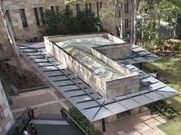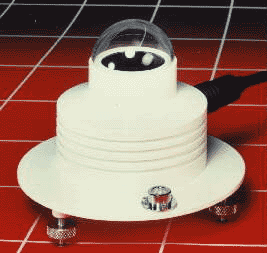I developed an interest in ultraviolet when I was given the role of University Radiation Officer at the University of Queensland. A previous URO, Dr Don Robertson (1914-2006) was part of the Department of Physics and looked after the (unmarked) sandstone Radon Lab on the Great Court at the university.
The door in the wall at the near end was made through the end wall of the walk-in radiation safe.
The Radon Lab was built in 1956 to house the Queensland Radium Institute (now at the Mater Hospital as the Queensland Radium Institute Mater Centre) and housed a large walk in radiation safe for the large radon rig which allowed gold capillaries to be filled with radon gas for radiotherapy.
Don’s PhD (1972) “Solar ultraviolet radiation in relation to human sunburn and skin cancer” led to the Robertson-Berger UV Meter and his seminal work of the protection done by sunscreens. Various prototypes of the meter existed in drawers in the Radon Lab, along with boxes of special UV glass and phosphors.
I spent some time with Don and learned a little of his work and the construction of the Roberson-Berger meter and his UV apparatus.
MODEL 501- UV Biometer is the continuation of the line of Robertson-Berger Weatherproof meters, that have been employed in the worldwide network for UV-B monitoring. The UV-Biometer has been designed by D.Berger and M.Morys, based on the experience gained during the Robertson-Berger meter design (Berger 1976) and of research focused on the temperature dependency and stabilization of the Robertson-Berger UV-B sensor (Blumthaler, Ambach, Morys, Slomka 1989).
The prototypes were about 10 cm diameter and 30 mm thick and made of brass and did not have the protective dome. The electronics was primitive by today’s standards. I had some contact with the University Archivist and I hope some of his work is preserved.
The meter took a lot of trial and error to construct and had a response similar to that of the skin (UV Action spectra). The principal was:
- UV first passed through UV glass to strip off the visible light and landed on a glass plate covered with a phosphor.
- The phosphor glowed and the green light pass through a green glass
- The green light then fell on a photodetector which produced an electrical signal.
The trick in the design was to make the instrument respond to a wide range of UV light and effectively have the UV action spectra of the skin to sunburn. Don had sourced a lot of phosphors from makers in New York who were mainly Jewish, and they closely guarded the secrets of their phosphors. I think he sourced his samples of UV glass from the US and Europe – another box. The green glass and photocell both added to the complexity of the UV response. Don also developed special techniques of coating and bonding the phosphor to glass.
This involved floating the phosphor powder on water in an even layer and gently lifting it off with a glass plate.
This was my type of physics.
More in other posts on his 0.8 micron cuvette for measuring sunscreens and other properties of UV.


